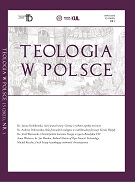Dramat Golgoty objawia wierność Stwórcy wobec stworzenia. Ukrzyżowany Syn Boży stanowi dość trudny do odczytania, a jednocześnie bardzo wymowny znak „usprawiedliwienia” Boga, Stworzyciela nieba i ziemi. Krzyż Chrystusa nie może być natomiast odczytany jako motyw aktu oskarżenia Ojca, że opuścił swego Syna. Trzeba bowiem pamiętać o wierności Ojca także wobec Syna. Ukrzyżowany zostaje przez Niego przyjęty. Umęczony, zdjęty z krzyża, złożony do grobu, nie odchodzi ze sceny zbawczego dramatu. „Bóg wskrzesił Go trzeciego dnia” (Dz 10,40) oraz „wywyższył Go na prawicę swoją jako Władcę i Zbawiciela” (Dz 5,31). Dokonało się to mocą miłości, mocą Ducha Świętego (por. Rz 8,11).
THE CHRIST’S CROSS IS THE CROSS OF THE SON. A PERSONALISTIC CONTRIBUTION TO THE TRINITARIAN CONCEPTION OF THE ECONOMY OF SALVATION
Summary
The article discusses the question about the passion and death of Christ on the cross. This subject by analogy is taken in the context of the suffering of children and their parents. Jesus Christ is the Son of the God. The Incarnation, earthly life, passion and death on the cross have not changed this fact. Jesus is always the Son of the Father. Falsely accused, unjustly convicted, inhumanly beaten, dying on the cross – is always the Son of the Father. One cannot accuse Father of shedding the blood of the Son. The drama of Golgotha proves that the Father is faithful to his creation. The Resurrection shows that the Father has always remained faithful to the Son. Dying, the Son has given himself into the Father’s hands (Lk 23:46). Rising from the dead, Jesus demonstrated his reception by the Father. The Mother of the Redeemer was present on Golgotha. The Son and Mother by their suffering made a community of obedience to the Father. The source of this obedience is love.
Ostatnia aktualizacja: 30.06.2014, godz. 15:17 - Natalia Haniewska































